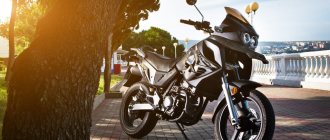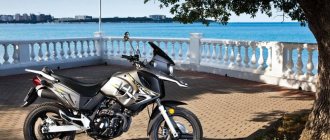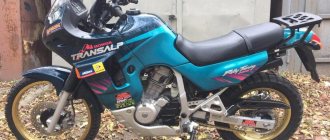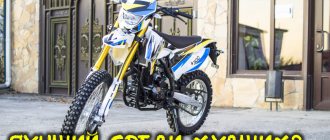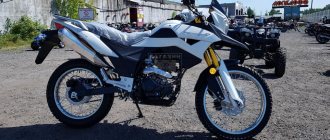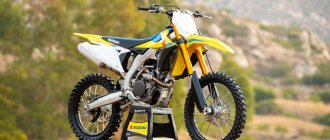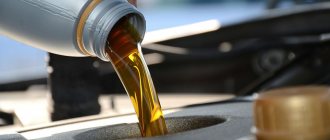Technical specifications of KTM Duke 250
Obviously, the Austrians made every effort to make the “quarter-liter” Duke as light as possible, which, by the way, unlike the Duke 200, is assembled in Austria and not in India. In a lightweight birdcage frame coated with a chrome-molybdenum alloy, they placed a 1-cylinder 31-horsepower liquid-cooled engine , an injector, and a 6-speed gearbox , putting it all together so that the power unit turned out to be very compact. The KTM Duke 250 turned out to be light, its dry weight is just under 150 kg , and thanks to its ideal weight distribution, it subjectively seems completely weightless.
The racing roots of the KTM Duke 250 are felt in everything - in the assembled and compressed landing, sporty aggressive suspension , sharp but very effective brakes , which, by the way, are complemented by an ABS system . At the front there is the same 300 mm brake disc with a 4-piston caliper as on the 200 Duke, and at the rear there is a 230 mm brake disc with a 1-piston caliper. Considering the small weight of the motorcycle, it really brakes very effectively, and it also accelerates, quickly reaching 150 km/h on the speedometer. The suspension allows you to make sharp maneuvers without really thinking about how the bike will behave, and the work of the 43 mm upside-down fork deserves special praise. It’s only a pity that the Austrians did not install suspension adjustments other than the preload of the rear monoshock absorber, but this would have been too much for an inexpensive motorcycle, which, strictly speaking, the KTM Duke 250 is.
Engine KTM 250 XC-F 2021
The 2021 KTM 250 XC-F engine produces smoothly increasing thrust from bottom to top. It has very good lows, powerful mids and excellent highs. Of course, it wouldn’t hurt to have more low-end traction, especially for difficult off-road conditions. The main thrust is at the top, and the Brembo hydraulic clutch allows you to keep the engine constantly revved up, regulating the thrust with the clutch thanks to a soft and smooth release. On fast sections and cross-country trails, the KTM 250 XC-F's traction is excellent, building predictably and controllably right up to the redline.
The six-speed gearbox from Pankl Racing Systems has fairly close gears. It shifts smoothly and performs great both off-road and on the motocross trail. First gear handles the tough terrain well, but on easier sections we rode in second and third, as well as on most cross-country trails. We switched to fourth on long straights, and fifth and sixth are elevated here, they are needed for clean clearings or roads.
Pros and cons of KTM Duke 250
Advantages
- High technology and impressive characteristics , especially by the standards of the class.
- Budget, but convenient and functional dashboard .
- The entire design is well thought out down to the smallest detail, right down to the backlighting of the buttons on the remote controls.
- A spacious 13.4-liter gas tank , and, accordingly, an impressive range, given the fuel consumption of 30-3.5 liters per hundred.
- The fit is comfortable even for those with tall stature and long legs.
- Unification of spare parts with many other models - Duke 125, 200 and 390.
- Slipper clutch and one-finger assist system.
Flaws
- High price . For the price of a new KTM Duke 250 you can buy an excellent and not too old used bike of a higher class.
- A regular lamp instead of an LED one. For ~300 thousand rubles it would be possible to install a better head light.
- Complexity of some service operations . Most of them require a visit to the dealer.
- For two, the KTM Duke 250 is clearly too small , and the dynamics immediately sags noticeably if there is a passenger.
2021 KTM 250 XC-F Suspension
The balance of the 2021 KTM 250 XC-F suspension settings leans towards comfort, and you immediately notice the softer nature of the WP AER 48 fork and WP rear monoshock compared to those on the 250 SX-F motocross. At stock pressure of 9.6 bar, the fork absorbs shocks well, swallows bumps and ruts. It also copes well with larger loads, for example during landings, including side ones. The soft nature of the fork is mainly felt on the motocross track, especially when flying over jumps and folding during a jump. In these situations, the fork can puncture, and this can be avoided by tightening it two or three compression clicks. The rear shock absorber copes with obstacles, acceleration and braking perfectly. When moving over obstacles, the shock absorber helps the rear to maintain traction with the obstacle and pass it with pinpoint precision.
Reviews from KTM Duke 250 owners
It is very wrong to look at the Duke-chekushka as a moped for dummies; this is really a full-fledged motorcycle, smart and daring, like the boys at the entrance. He knows how to ride calmly, but he doesn’t like it. It reacts adequately to a sharp opening of the gas, brakes at 5+, and steers with two fingers. In the city, it’s generally much better than a liter, because it doesn’t weigh anything. Outside the city, of course, there is not enough power, but this is a city mot after all. Sergey, St. Petersburg, KTM Duke 250 '2017.
Overall a good motorcycle, I rode it for a season, sold it, and managed to form an opinion. It’s expensive for a 250cc, but the cheapness is visible in places, the instrumentation, for example, doesn’t have anything, there’s no connection to a smartphone, like on older Dukes, and that headlight is poor. Although these are minor things, of course, no one skimped on the main ones. The motorcycle was picked up new, covered approximately 7,500 km and serviced at the dealer - no comments. Alexander, Moscow, KTM Duke 250 '2017.
I was choosing between the Yamaha MT03 and the Duke, and ultimately chose the latter. I tested both, the Duke feels more fun, and definitely handles better. I've only been driving for two months, then the season has already closed, I'll continue soon. The motik is cool overall. Grigory, Moscow, KTM Duke 250 '2018.
About six months have passed since purchasing this device. I switched to it from the fierce Chinese Kayo T2. In this post I want to write the pros and cons of this endurik, because... I didn’t really find anything about it before purchasing it. Just general information on the type: KTMs break down and KTMs are expensive to maintain. And on the other hand, everyone shouted that KTM is a thing, we must take it. All. I didn’t find anything else (maybe I was looking in the wrong place). Let's move on to a mini-review of its advantages. I compared it with my previous motorcycle and the motorcycles of my friends with whom I ride. -HYDRAULIC CLUTCH is stock on the 2007 model. Incredibly soft and informative release. For six months it did not cause any problems. Judging by the machine itself, it has been working properly since 2007)) For example, the Honda CRF250-450 of the same year comes stock with a cable. KLX 250 - also a cable. -BREMBO BRAKES are also stock. Front and rear. Calipers and brake machines with cylinders. After I rode all my friends’ bikes, I realized that the KTM has mega-informative brakes. Everyone who rode it noted this. The cost of the pads is from 700 to 1500 rubles, depending on the manufacturer. When I drive almost every Saturday, it lasts for a long time, I changed the pads when I bought the bike, and I’m still driving. -The PLASTIC of this motorcycle is a thing. There were many encounters with the front wing trees. The wing arches and looks into my eyes, and when you move the moto away from the tree, it simply falls into place. Moreover, there are no creases left, no white stripes either. The tail is the same as the courses I tried with hard landings, it withstood everything. Also very scratch resistant. -I have never tightened the SPOKES during the weather... because they do not loosen. Hobby partners do this every few rides. The needles are very thick. Especially in comparison with Kayo T2, there they looked like strings. Same thing on KLX. -The weight distribution on the moped is ideal, these are the first words of any person who has ridden it. You can really feel that all the weight is concentrated somewhere in the area of the pegs. This allows you to steer and maneuver with the ease of a bicycle. -PROGRESSIVE REAR SHOCK ABSORBER. Many people write that this is complete bullshit... I don’t understand why. There is no progression hanging from below, so there is no need to service it. The shock absorber, of course, also needs to be serviced, the bushings with bearings at the mounting points must be changed, for example. I changed it. Spent about 30 minutes. You can't handle progression in 30 minutes. The softness of the suspension is certainly captivating. So far, not one endurik has given such sensations as this one. -FILTER-BOX, or rather the availability of the filter and the ease of replacing it. But now almost all motors have an affordable and quick filter replacement.
I'll write down the disadvantages: -FUEL CONSUMPTION AND SMALL TANK. A 6-7 liter tank can be rolled out very quickly. I will already run out of gas, but my kids will still ride and ride... The last time it was enough for a 60 km drive. Before that I spent 40 km. Everywhere driving through the forest. -HEADLIGHT. He's gone. It just shines on the wheel. Replace immediately if you ride in the dark. I don’t drive at night and don’t change. -TUNING PRICE. There are a lot of tuners, just a great variety. But the range is only in Europe and America. Accordingly, the price and delivery are steep.
I would love to insert photos, but I didn’t figure out how to insert them, so nothing happened. You can see how we ride on our Youtube channel - Enduro KRD Thank you all!
Similar models
- Kawasaki Z250. The youngest representative of the famous Z-series is a very serious competitor, and probably one of the best representatives of the 250 cc bike class.
- Yamaha MT-03 . A popular road bike, modern, quick to accelerate, technologically advanced and generally very beautiful. In addition, it costs moderate money.
- Suzuki GW250 . Almost similar to the Duke 250 in price and technical characteristics, although in design, of course, it is completely and irrevocably inferior to it.
Chassis and handling
The KTM 250 XC-F handles precisely and intuitively. It holds a straight line beautifully and, thanks to a stiffer frame for the 2019 model year, handles better than ever. In difficult areas, it responds quickly and predictably to the rider's inputs. The chassis is perfectly balanced with a sag of 105 mm. The Brembo brakes are powerful and progressive, with braking force easily modulated. The ergonomics of the KTM 250 XC-F in the 2021 model have also been improved in terms of narrower plastic radiators. The location of the footpegs is 6mm higher than the cross quarter. The anti-slip seat has soft padding and is comfortable when you move your weight on it. The Neken handlebars have a medium height and a comfortable angle for most riders. The handlebars are equipped with high-quality lock-on grips from ODI, and the rider's levers and hands are protected by orange guards, which is always a plus for an off-road bike. It would be nice if the stock package included crankcase protection, especially considering that the frame already has mounts for it.
Video Review
Specifications
| Maximum engine power: | 31 HP |
| Working volume: | 248.8 cm3 |
| Motor type (cylinder arrangement, number of strokes): | 1-cylinder, 4-stroke, in-line |
| Number of cylinders: | 1 |
| Number of valves: | |
| Intake type (Injector / Carburetor): | |
| Bore and stroke: | |
| Starting system (Electric starter, kick starter): | |
| Maximum speed in km/h: | 140 km/h |
| Cooling system: | Liquid |
| Transmission (gearbox): | Mechanical 6-speed |
| Clutch (Dry / Wet): | |
| Drive unit: | Chain |
| Frame: | Steel tubular |
| Chassis | |
| Suspension (front/rear travel): | |
| Brakes (Front/Rear): | |
| Wheels / Tires / Rubber: | |
| Dimensions and weight | |
| Dimensions (Length / Width): | |
| Seat height: | |
| Ground clearance: | |
| Curb weight: | |
| Wheelbase: | 1357 mm |
| Weight: | 149 kg |
| Fuel tank capacity: | 13.4 l. |
| Battery capacity: | |
| Year of release: | |
| Country of Origin: |
Lightweight fighter
2015 model year, 249 cm3, 108 kg, 656,900 rub.
text: Yuri Solonovich photo: Marco Campelli, KTM-Sportmotorcycle AG
in the photo: Yuri Solonovich
»You can argue for as long as you like about the advantages and disadvantages of various types of enduro motorcycles, but two-wheeled vehicles equipped with 4-stroke power plants with a cylinder displacement of 250 cm3 remain the most friendly and convenient sports equipment for riders of any level of training.
I would not like to enter into a meaningless and merciless argument with fans of classic 2-stroke enduros, but it is the 4T “checks” that are most in demand in this market today. With such machines you can easily begin to understand the diverse world of off-road freeride, and they will be the most convenient for a beginning endurist.
And these motorcycles certainly won’t make an experienced rider yawn boredly while driving! Of course, we are talking exclusively about “sports enduro” class devices, and I do not take into account the classic Japanese dull “trail bikes” like the Yamaha TTR250 or Suzuki DR250. Today, the virtually uncontested manufacturer of enduro fighters is, of course, the Austrian company KTM, in whose production shops the current experimental 250 EXC-F was born.

